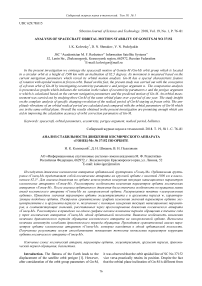Analysis of spacecraft orbital motion stability of Gonets-M No 37152
Автор: Kolovsky I.K., Shmakov D.N., Podolyakin V.N.
Журнал: Сибирский аэрокосмический журнал @vestnik-sibsau
Рубрика: Авиационная и ракетно-космическая техника
Статья в выпуске: 1 т.19, 2018 года.
Бесплатный доступ
In the present investigation we envisage the spacecraft motion of Gonets-M (Gn-M) orbit group which is located in a circular orbit at a height of 1500 km with an inclination of 82.5 degrees. Its movement is measured based on the current navigation parameters which reveal its orbital motion analysis. Gn-M has a special characteristic feature of rotation with apsidal motion in frozen orbit. Based on this fact, the present study was carried out with the conception of a frozen orbit of Gn-M by investigating eccentricity parameter e and perigee argument w. The comparative analysis is presented as graphs which indicates the variation in the values of eccentricity parameters e and the perigee argument w which is calculated based on the current navigation parameters and the predicted motion of Gn-M. An orbital meas- urement was carried out by studying three Gn-M of the same orbital plane over a period of one year. The study insight on the complete analysis of specific changing revolution of the nodical period of Gn-M staying at frozen orbit. The am- plitude vibrations of an orbital nodical period are calculated and compared with the orbital parameters of Gn-M which are in the same orbital plane. Overall the results obtained in the present investigation are promising enough which can aid in improving the calculation accuracy of orbit correction parameters of Gn-M.
Spacecraft, orbital parameters, eccentricity, perigee argument, nodical period, ballistics
Короткий адрес: https://sciup.org/148177804
IDR: 148177804 | УДК: 629.78.015
Текст научной статьи Analysis of spacecraft orbital motion stability of Gonets-M No 37152
Introduction. The flatness of the Earth leads to the displacement of the satellite orbit perigee [1]. However, after consideration of the orbit group parameters of Gn-M, it was observed that the orbit apsidal line of SC No 37152 vice versa practically retains its position. Despite the fact that the orbital plane inclination of Gn-M is different from the critical value (the critical inclination equal to 63.43 degrees and 116.57 degrees).
It was found out that after the reduction correction Gn-M No 37152 hit the target orbit at a height of 1500 km with an inclination of 82.5 degrees with special laws changes in the orbit parameters – frozen orbit.
The study of the evolution of the orbital parameters e and w of Gn-M. A frozen orbit is an orbit whose mid elements, particularly the eccentricity e and the perigee argument w , for a long period of time can take almost constant or within a limited range enclosed values [2–4].
Analysis was studied by measurements of current navigation parameters (MCNP) of SC’s No 37152, No 38736, No 38734 which are located in the same orbital plane. Special attention was paid to the following SC orbit parameters: e , w and the nodical period T nd .
Due to the analysis it turned out that the parameters, obtained after processing MCNP of SC’s No 38736, No 38734 behave in the following way: w changes in the range from 0 degree to 360 degrees, i. e., it has secular changes, e changes in the range from 0.001 to 0.003. The nodical period Tnd in addition to the secular component has got a long-period one. On the other hand, orbit parameters w and e of SC No 37152 change in a completely different way (tab. 1).
It must be noted that SC No 37152 is different in behavior of the considering orbital motion elements according to its own points A1–A5 (tab. 1) in comparison with parameter values at points B1–B5 and C1–C5 of other SC’s and in addition to this its secular component of the perigee argument change disappeared.
Therefore, further for the study, we take the values obtained by MCNP, orbit parameters e and w of SC’s No 37152, No 37836 and No 38734 over a period of one year (tab. 1) and compare these values with the predicted values of e and w . The forecast will be carried out taking into account the influence of the Sun, moon and the resistance of the atmosphere over a period of one year. All the corresponding values will be presented in one graph (fig. 1–3).
Table 1
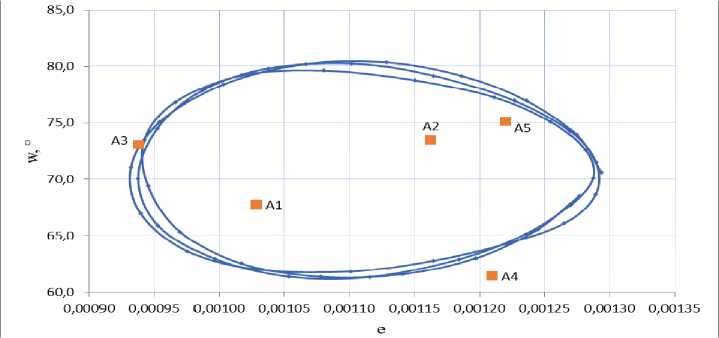
Fig. 1. e , w orbit parameters change of SC No 37152 over a period of one year
The MCNP results of SC’s No 37152, No 38736, No 38734
SC No 37152
|
№ |
Date |
Т nd , с |
e |
w , ° |
i , ° |
|
А1 |
04.06.16 |
6955.066 |
0.0010284 |
67.778 |
82.460 |
|
А2 |
06.07.16 |
6955.067 |
0.0011624 |
73.497 |
82.460 |
|
А3 |
06.11.16 |
6955.046 |
0.0009379 |
73.050 |
82.459 |
|
А4 |
06.03.17 |
6955.042 |
0.0012092 |
61.417 |
82.461 |
|
А5 |
07.07.17 |
6955.019 |
0.0012199 |
75.115 |
82.463 |
|
SC No 38736 |
|||||
|
№ |
Date |
Т nd , с |
e |
w , ° |
i , ° |
|
B1 |
29.06.16 |
6955.032 |
0.0032782 |
70.250 |
82.484 |
|
B2 |
22.09.16 |
6954.957 |
0.0010319 |
238.830 |
82.484 |
|
B3 |
16.11.16 |
6954.955 |
0.0028615 |
107.508 |
82.487 |
|
B4 |
17.03.17 |
6954.950 |
0.0011888 |
197.741 |
82.488 |
|
B5 |
17.07.17 |
6954.914 |
0.0019047 |
349.824 |
82.486 |
|
SC No 38734 |
|||||
|
№ |
Date |
Т nd , с |
e |
w , ° |
i , ° |
|
С1 |
29.06.16 |
6954.913 |
0.0030670 |
69.888 |
82.479 |
|
С2 |
21.08.16 |
6954.883 |
0.0017654 |
177.554 |
82.475 |
|
С3 |
26.11.16 |
6954.899 |
0.0028563 |
91.390 |
82.482 |
|
С4 |
27.03.17 |
6954.905 |
0.0014133 |
163.996 |
82.484 |
|
С5 |
05.05.17 |
6954.892 |
0.0027339 |
99.380 |
82.483 |
Рис. 1. Изменение параметров е , w на орбите КА № 37152 на интервале одного года
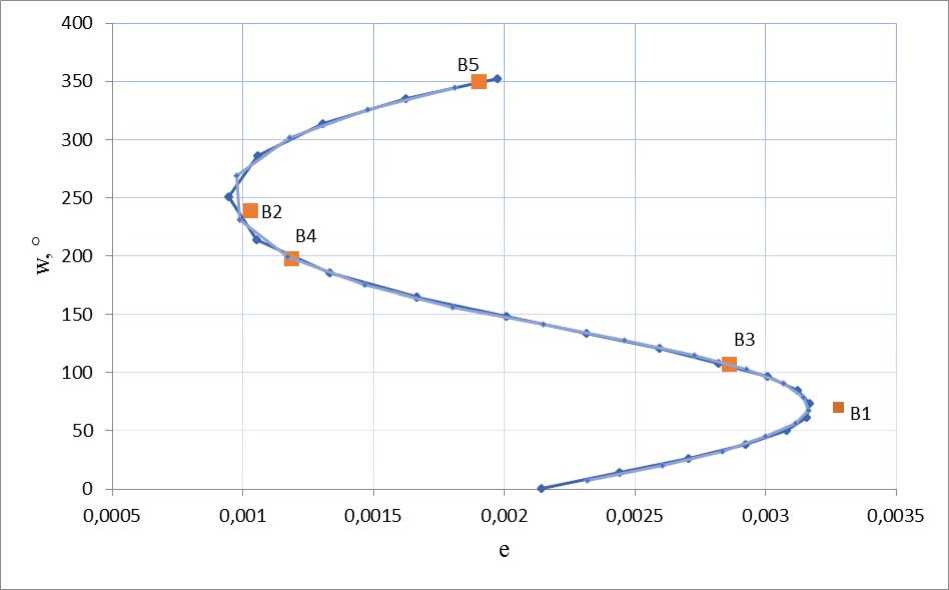
Fig. 2. e , w orbit parameters change of SC No 38736 over a period of one year
Рис. 2. Изменение параметров е , w на орбите КА № 38736 на интервале одного года
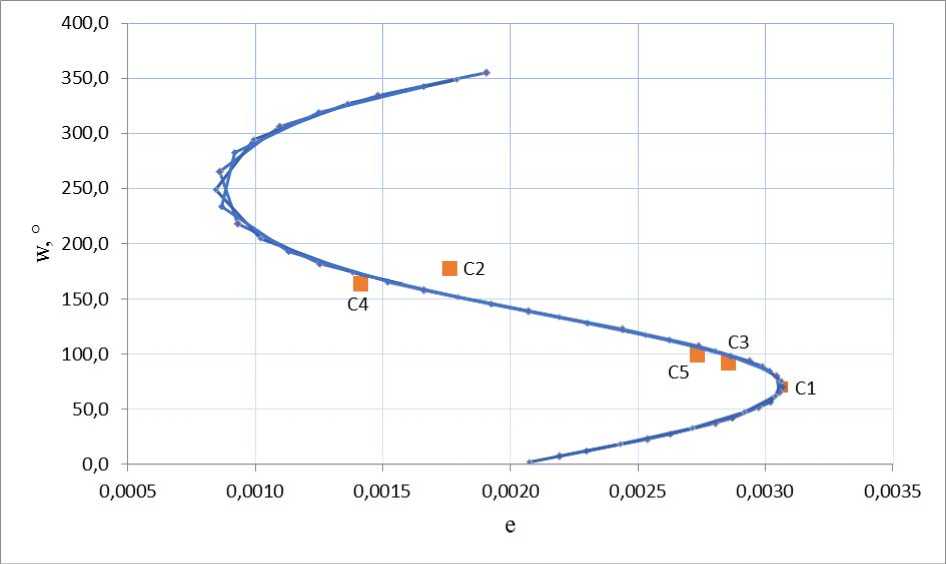
Fig. 3. e , w orbit parameters change of SC No 38734 over a period of one year
Рис. 3. Изменение параметров е , w на орбите КА № 38734 на интервале одного года
At the fig. 1, 2 and 3 it can be seen that the values obtained by MCNP are in good agreement with the values calculated by the forecast of SC orbit motion.
Looking at tab. 1 and fig. 1 it can be concluded that in a frozen orbit parameters e and w of SC No 37152 are changing in the following intervals of values
0.0009 < e < 0.0013; 60.0° < w < 80.0° (1)
The obtained inequalities of e and w changes are assumed as a condition for SC being in a frozen orbit at an orbit height of 1500 km with an inclination of 82.5 degrees.
The orbit period changes of Gn-M. Consideration should be given to the nodical period T nd of Gn-M. The observation of the T nd secular changes according to the NORAD database [5] shows that SC No 37152 has significant decreasing of the amplitude of the long-period component in the nodical period, compared to SC No 38736 and SC No 38734 of the same orbital plane and of the same location in a non-frozen orbit (fig. 4).
It is necessary to pay attention to one more feature of carrying out calculations by T nd using. It is talked about the influence of TGF tesserial harmonics on the average anomaly. These harmonics cause secular perturbation in the average anomaly, what corresponds to the SC secular drift along the trajectory. This secular drift should be taken into account in project calculations where the initial conditions are the use of the sculating orbital elements at some point. If T nd is used as initial conditions, this perturbation should not be taken into account, since it is included as a component of nodical period initial value [6; 7].
The analysis of the secular change in T nd circulation period by all three SCs Gn-M shows that every SC T nd value over a period of one year, starting since 01.06.2016, decreased an average of ~ 0.04 s.
Considering fig. 4 in greater detail, the significant amplitude decreasing of the long-period component can be noted in the nodical period of Gn-M No 37152. The changing nature of treatment period became smooth over time.
The difference in T nd values changes of SC No 37152 and T nd of other orbit group SCs can be explained due to the influence of long-period perturbations [8].
The oscillation amplitude changes of Gn-M sidereal period in orbit. The long-period component is generated by the long-period oscillations of the nodical period, which have an amplitude [9–11]
А т = 3- C 2^ (R э/ a ) 2 T nd (2 - (5-sin 2 ( i ))/2)- e , (2)
where C 2.0 = –1082.627∙10–6 – dimensionless constant characterizing the shape of the Earth; R э = 6378.16 km -the equatorial radius of the Earth [12; 13]; e – the eccentricity of orbit turn; a = 7878.16 km – a large orbit axis; T nd = 6955.0 s – the initial value of Gn-M orbit nodical period [14]; i = 82.5 degrees – the inclination of orbital plane.
On substituting values into expression (2), the following formula is obtained
А Т = 6.8∙ e . (3)
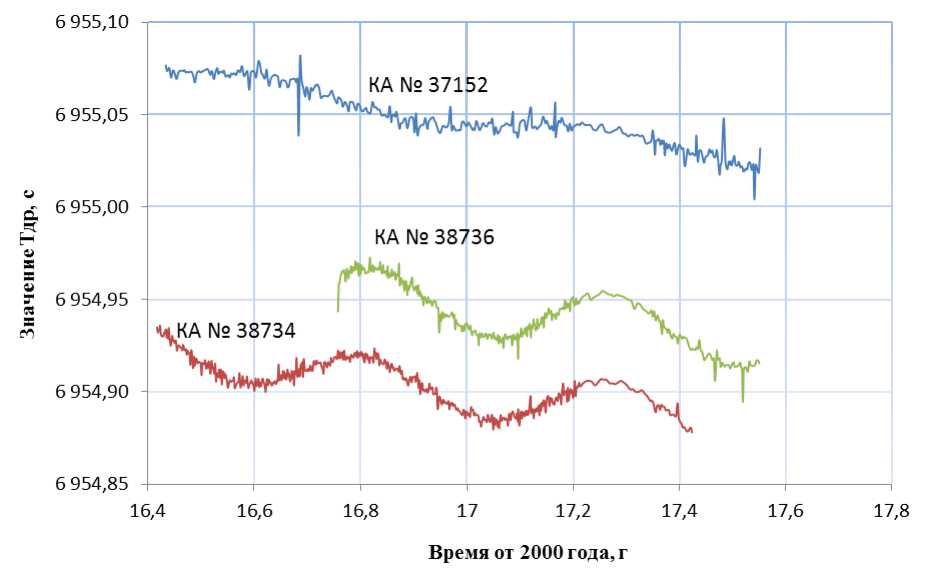
Fig. 4. T nd change of SC No 37152, SC No 38736 and SC No 38734
Рис. 4. Изменение Т др КА № 37152, КА № 38736 и КА № 38734
Table 2
A T , ( T nd ) dk calculations results following MCNP data
|
SC No 37152 |
|||||
|
Date |
e |
w , ° |
А Т |
( Т nd) dk , с |
1/2∙( Т nd ) dk , с |
|
04.06.16 |
0.0010284 |
67.778 |
0.00699 |
–0.00265 |
–0.00133 |
|
06.07.16 |
0.0011624 |
73.497 |
0.00790 |
–0.00225 |
–0.00113 |
|
06.11.16 |
0.0009379 |
73.050 |
0.00638 |
–0.00186 |
–0.00093 |
|
06.03.17 |
0.0012092 |
61.417 |
0.00822 |
–0.00394 |
–0.00197 |
|
07.07.17 |
0.0012199 |
75.115 |
0.00830 |
–0.00214 |
–0.00107 |
|
SC No 38736 |
|||||
|
Date |
e |
w , ° |
АТ |
( Т nd) dk , с |
1/2∙( Т nd) dk , с |
|
29.06.16 |
0.0032782 |
70.250 |
0.02229 |
–0.00755 |
–0.00377 |
|
22.09.16 |
0.0010319 |
238.830 |
0.00702 |
0.00364 |
0.00182 |
|
16.11.16 |
0.0028615 |
107.508 |
0.01946 |
0.00584 |
0.00292 |
|
17.03.17 |
0.0011888 |
197.741 |
0.00808 |
0.00770 |
0.00385 |
|
17.07.17 |
0.0019047 |
349.824 |
0.01295 |
–0.01274 |
–0.00637 |
|
SC No 38734 |
|||||
|
Date |
e |
w , ° |
АТ |
( Т nd) dk , с |
1/2∙( Т nd) dk , с |
|
29.06.16 |
0.0030670 |
69.888 |
0.02086 |
–0.00718 |
–0.00359 |
|
21.08.16 |
0.0017654 |
177.554 |
0.01200 |
0.01199 |
0.00600 |
|
26.11.16 |
0.0028563 |
91.390 |
0.01942 |
0.00046 |
0.00023 |
|
27.03.17 |
0.0014133 |
163.996 |
0.00961 |
0.00923 |
0.00462 |
|
05.05.17 |
0.0027339 |
99.380 |
0.01859 |
0.00301 |
0.00151 |
In this case, the long-period oscillations of nodical period ( T nd ) dk at the time of equator passing take the following form [9–11] in the turn
( Т nd ) dk = – АТ ∙cos( w ), (4) where w is the value of the orbit perigee argument in the turn.
Following MCNP data the Gn-M orbits eccentricity is being ranged between 0.001 and 0.004. It follows that the long-period component amplitude of the nodical period АТ is 0.007–0.030 s according to the formula (3).
If Gn-M No 37152 is moving along frozen orbit, its АТ change is different. To check this situation actual values obtained by MCNP, w and e parametres results are taken out of the tab. 1, formulas (3), (4) are used for calculations (tab. 2). In tab. 2 parameter 1/2 ∙ ( T nd ) dk means the semirange of T nd long-period oscillations.
It must be noted that the value (T nd ) dk depends on time. Comparing presented in tab. 2 parameter 1/2∙(T nd ) dk with the values of the T nd . behavior by its real observations (see fig. 4) it can be seen that in both cases the semirange of the long-period oscillations of Tnd period is about 0.001 s in magnitude. In the tab. 2 t SC No 37152 eccentricity changes from 0.0009 to 0.0013, thus the long-period component amplitude of the nodical period changes in closer limits from 0.007 to 0.009 s.
Conclusion. Presented data point to a potentially promising application area of orbits as a frozen orbit. The detection of the nature changes in the motion of SC Gn-M No 37152 in such an orbit can aid in improving the calculation accuracy of orbit correction parameters, which will be relevant by increasing the number of Gn-M orbit groups, as is proposed in [15], and by a significant reduction of SC retention area at the necessary points of standing, i. e., in connection with the requirements increasing to the structural stability of the orbital group.
Список литературы Analysis of spacecraft orbital motion stability of Gonets-M No 37152
- Балк М. Б. Элементы динамики космического полета. М.: Наука. Глав. ред. физ.-мат. лит., 1965. 338 с.
- Электронная база данных командования воздушно-космической обороны Северной Америки (NORAD) . URL: https://www.space-track. org (дата обращения: 19.06.2017).
- Дубошин Г. Н. Небесная механика. Основные задачи и методы. М.: Наука, 1968. 799 с.
- Satellite Orbits: Models, Methods and Applications. 1st Ed. Oliver Montenburck, Eberhard Gill. -Springer Science & Business Media, 2000. Р. 369.
- Подолякин В. Н., Шмаков Д. Н., Коловский И. К. Исследование изменения драконического периода обращения космического аппарата «Гонец-М»//Решетневские чтения: материалы XXI Междунар. науч. конф. (08-11 ноября 2017, г. Красноярск). В 2 ч. Ч. 1/под общ. ред. Ю. Ю. Логинова; СибГУ им. М. Ф. Решетнева. Красноярск, 2017. С. 38-40.
- Назаренко А. И., Скребушевский Б. С. Эволюция и устойчивость спутниковых систем. М.: Машиностроение, 1981. 284 с.
- Жонголович И. Д. Возмущения искусственного спутника в гравитационном поле Земли//Бюллетень института теоретической астрономии. 1960. Т. VII, 10, 93. 182 с.
- Каула У. Спутниковая геодезия. М.: Мир, 1970. 172 с.
- Эльясберг П. Е. Введение в теорию полета искусственных спутников Земли. 2-е изд. М.: ЛИБ-РОКОМ, 2011. 544 с.
- Аксенов Е. П.орТиея движения искусственных спутников Земли. М.: Наука, 1977. 367 с.
- Жаров А. Н. Многофункциональная система персональной спутниковой связи «Гонец-Д1М»: состояние и перспективы развития//Спутниковая связь и вещание. Спец. выпуск. М., 2014. С. 72-78.
- Модернизация орбитальной группировки малых космических аппаратов многофункциональной системы персональной спутниковой связи «Гонец-
- Orbital Mechanics/Edited by V. A. Chobotov; Д1М»/М. вВ. Вало //Решетневские чтения: American Institute of Aeronautics and Astronautics. Third Edition, 2002. Рр. 259-263.
- Cutting E., Born G. H., Frautnick J. C. Orbit Analysis for SEASAT-A//Journal of the Astronautical Sciences. 1978. Vol. XXVI. Рр. 315-342.
- Smith J. C. Analysis and Application of Frozen Orbits for the Topex Mission/American Institute of Aeronautics and Astronautics. Paper 86-2069-CP, Aug. 1986. материалы XX Междунар. науч. конф. (09-12 нояб. 2016, г. Красноярск). В 2 ч. Ч. 1/под общ. ред. Ю. Ю. Логинова; Сиб. гос. аэрокосмич. ун-т им. М. Ф. Решетнева. Красноярск, 2016. С. 618-619.

